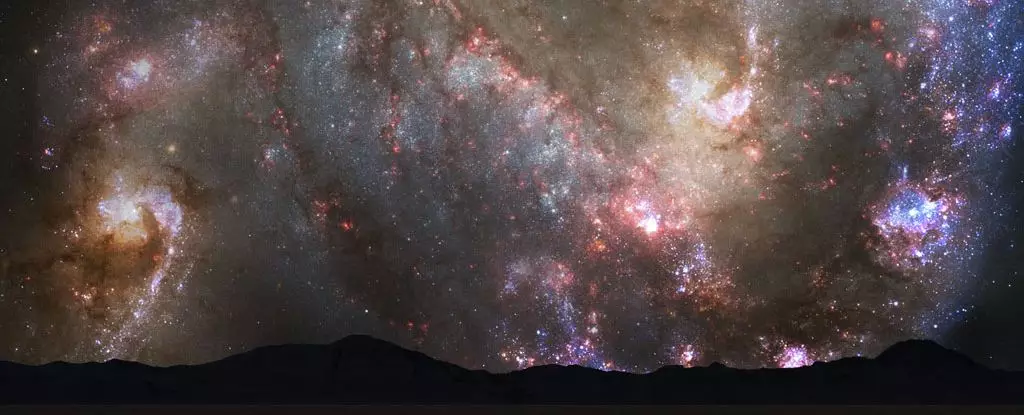The narrative surrounding the fate of the Milky Way galaxy has long been cloaked in dramatic predictions of an impending collision with its closest neighbor, the Andromeda galaxy. For years, scientists have heralded the end of the Milky Way as nearly inevitable, envisioning a spectacular merger that would forever reshape our cosmic neighborhood. However, recent research led by astrophysicist Till Sawala from the University of Helsinki has thrown a twist into this narrative. Instead of accepting a conflated doomsday scenario, Sawala and his team reveal a more nuanced outlook, suggesting that the emperor might not be wearing such ragged robes after all. Their calculations unveil a shockingly balanced possibility of collision and coexistence over the next 10 billion years, opening a window to exciting discussions about our place in the cosmic order.
Understanding the “Milkomeda” Theory
Previously, scientists believed that a merger—referred to as “Milkomeda”—between the Milky Way and Andromeda was almost predetermined within a 4.5 billion-year time span. However, what was presumed to be a straightforward event morphs into a more complicated affair when we refine our models. The Milky Way and Andromeda are not solitary giants; instead, they are part of the Local Group, encompassing other substantial galactic entities within a radius of about 5 million light-years. By looking at this broader cosmic context, the latest studies reveal that an encounter between these colossal galaxies entails numerous variables that significantly influence their potential collision paths.
Sawala’s team examined new data from the Hubble and Gaia space telescopes, focusing on the mass estimates of the four largest members of the Local Group—the Milky Way, Andromeda, the Triangulum galaxy (M33), and the Large Magellanic Cloud (LMC). By running simulations that included the complexities brought by these neighboring galaxies, they managed to lend credence to scenarios beyond a simple merger.
The Role of Galaxy Interactions
An interesting phenomenon occurs when M33 and LMC enter the picture. The dynamics among these galaxies affect the likelihood of a future collision significantly. In scenarios where only the Milky Way and Andromeda are considered, simulations predict a merging event slightly under 50% of the time. Adding M33 shifts the probability sharply upward to about 67%. Conversely, mapping out situations that factor in the LMC reduces the chances to around 33%. When all galaxies are present, the likelihood of a merger raises to just above 50%—implying a future that is not set in stone but rather a complex tapestry of interactions.
Sawala’s exploration reveals two primary potential outcomes: one where the Milky Way and Andromeda venture close enough during their first encounter to create a gravitational tug that prompts an eventual merger, and another where they glide past each other, orbiting for billions of years without binding. This insight grants us a more sophisticated understanding of cosmic time and space dynamics, revealing that the principles governing galaxy behavior may not be as deterministic as once assumed.
Limitations and Future Prospects
What makes this research truly captivating is its admission of uncertainty. Scientists have historically focused on understanding cosmic history—the “why” and “how” that brought us to this moment in the universe. However, Sawala shifts the gaze towards exploring prospective futures, which complicates matters even further. The notion that predicting cosmic interactions becomes significantly more difficult as we extend temporal horizons underscores the notion of chaos woven into the fabric of the cosmos.
The choice to evaluate a 10 billion-year timeframe raises critical questions about the future direction of astronomical research. Even as sophisticated data from contemporary instruments illuminate the paths of cosmic bodies, unforeseen dynamics could arise. The unpredictable nature of cosmic events could manifest, altering established trajectories and behaviors of galaxies. This admission paves the way for ongoing inquiry, where each step towards clearer measurements and interpretations could dramatically redefine what we believe to be the galactic future.
The Search for Understanding Continues
In closing, the research initiated by Sawala and his colleagues serves as a tantalizing reminder of the complexity of the universe. The future is fraught with uncertainty, which challenges comprehension but also fuels curiosity. As the scientific community delves deeper into the architecture of our cosmos, we can expect that emerging technologies and data will continue to refine our models and expectations.
The very act of grappling with these monumental questions fuels an awe of the cosmos that is both humbling and exhilarating, as we realize that our understanding of the Milky Way and its dance with Andromeda is but a reflection of our broader attempts to decipher a wondrous and unpredictable universe.


Leave a Reply